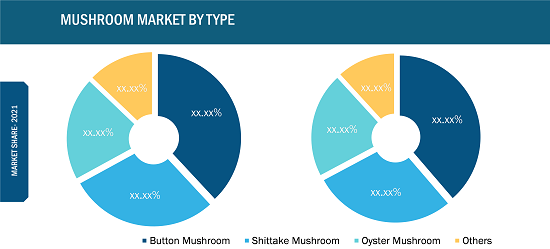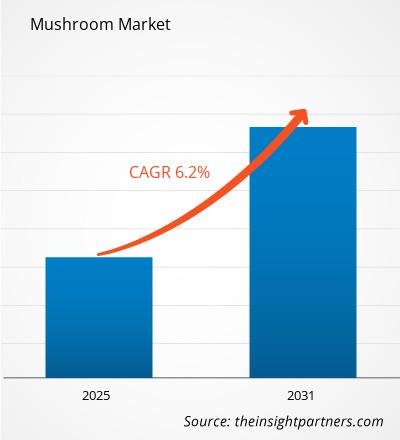蘑菇市场规模预计将从 2022 年的 136.7 亿美元增长到 19.63 美元到 2031 年将达到 10 亿;预计 2022 年至 2031 年复合年增长率为 6.2%。
食用菌是几种大型真菌的肉质、可食用的子实体。蘑菇主要种植在中国、美国、荷兰、法国和波兰。白蘑菇、奶油蘑菇、香菇、平菇、金针菇、鸡油菌、牛肝菌、波多贝罗蘑菇和棕色蘑菇是全球常见的蘑菇类型。蘑菇还富含硒和谷胱甘肽等抗氧化剂。此外,它们还含有高含量的维生素 B 和 D、磷、镁、钙和钾。
2021 年,亚太地区占据最大份额蘑菇市场;然而,预计欧洲在预测期内的复合年增长率最高。该地区市场的增长归因于消费者倾向于消费营养丰富的食品,以及由于蘑菇具有抗生素特性而增加其药用用途。人们还研究了它们与抗癌药物的协同作用。从蘑菇中提取的化合物或物质可用于免疫抑制剂、胆固醇抑制剂和精神药物。亚太地区是最大的蘑菇生产国,中国、日本、印度、泰国、菲律宾和印度尼西亚等国家是该地区产量的主要贡献者。政府促进蘑菇生产的举措也有利于该地区市场的增长。位于福州的亚太食用菌培训中心致力于研究、开发和国际技术培训。开展食用菌交流和经贸合作,推动食用菌产业化和国际化。
战略见解
COVID-19 大流行对蘑菇市场的影响
由于 COVID-19 大流行而实施的封锁、旅行限制和企业关闭对北美、欧洲、亚太地区 (APAC)、南美和非洲各国的经济和行业产生了不利影响。中美洲 (SAM)、中东和非洲非洲(MEA)。社会和商业限制随后导致供应链、制造活动、交货计划以及必需和非必需产品销售中断。然而,由于消费者对 的偏好增加,对蘑菇的需求增加植物性食品以及人们对蘑菇健康益处的认识不断提高。因此,制造活动的中断和需求的增加导致了供需缺口。 2021年,多家企业宣布蘑菇发货可能会延迟,并预计未来销量将出现下滑。此外,欧洲、亚太和北美各国政府对国际旅行实施的禁令迫使多家公司终止了合作和伙伴关系计划。
蘑菇市场细分(按地区)
< p>预测期内主要参与者推动蘑菇市场的战略发展
产品创新、工厂产能扩张、兼并重组收购是蘑菇制造商为巩固市场地位和扩大客户群而实施的关键战略之一。例如,Big Mountain Foods 宣布与肠道健康食品领域的领导者 Sprouts Farmers Market 合作,在北美推出第一条狮鬃菇产品线。因此,市场参与者的持续战略发展预计将在预测期内为蘑菇市场提供巨大的机遇。
类型洞察
根据类型,蘑菇市场分为蘑菇、香菇、平菇等。蘑菇细分市场在 2021 年占据最大的市场份额,预计 2022 年至 2031 年香菇细分市场的复合年增长率最高。由于孢子孵化时间较短,蘑菇是全球主要栽培的蘑菇。此外,蘑菇的成本低于其他类型,且营养价值众多,有利于该细分市场的市场增长。
蘑菇市场,按类型分类 - 2022 年和 2031 年
 类别洞察
类别洞察
根据类别,蘑菇市场分为有机蘑菇和传统蘑菇。 2021 年,传统细分市场占据了更大的市场份额。然而,预计有机细分市场在预测期内的复合年增长率将更高。各国传统上使用化肥和农药种植各种蘑菇。这些类别使用转基因生物,确保作物产量稳定。然而,随着有机产品因其高品质和可持续性而越来越受欢迎,未来几年对传统产品的偏好可能会减少。然而,由于传统蘑菇的经济性和可用性,当地食品制造商可能会继续使用传统蘑菇。
乔治新鲜公司; B 和 G 食品公司; Banken Champignons BV;蒙特利蘑菇有限责任公司;伍德斯托克食品;邦杜埃勒公司;莫纳汉集团;沃尔什蘑菇集团;铁匠铺蘑菇;和 Bluff City Fungi 是蘑菇市场的主要参与者之一。这些公司主要注重产品创新,以扩大市场规模并追随新兴市场趋势。预计此类产品在预测期内将受到消费者的高度关注。
报告焦点
- 蘑菇市场的进步行业趋势,帮助企业制定有效的长期战略
- 市场参与者采用的业务增长策略发达国家和发展中国家
- 2022年至2031年市场定量分析
- 全球蘑菇需求估算
- 波特的五力分析说明了蘑菇市场中买家和供应商的功效
- 了解竞争市场情况的最新进展
- 市场趋势和前景,以及市场驱动因素和限制
- 通过突出蘑菇市场参与者的策略来协助决策过程
- 各个节点的蘑菇市场规模
- 市场详细概述和细分,以及蘑菇行业动态
- 各地区蘑菇市场规模及增长机遇
- 历史分析(2 年)、基准年、预测(7 年)及复合年增长率
- PEST 和 SWOT 分析
- 市场规模价值/数量 - 全球、区域、国家
- 行业和竞争格局
- Excel 数据集



Report Coverage
Revenue forecast, Company Analysis, Industry landscape, Growth factors, and Trends

Segment Covered
This text is related
to segments covered.

Regional Scope
North America, Europe, Asia Pacific, Middle East & Africa, South & Central America

Country Scope
This text is related
to country scope.
常见问题
Ans. The Asia Pacific region led the mushroom market with the highest market share in 2018. The continuous economic growth in developed and developing countries like India and China, coupled with the presence of huge disposable incomes with individuals in countries like Japan and Australia, has facilitated the rapid growth of the automotive industry in this region. China is the largest producer of mushrooms in the APAC region. The production in the region is mostly devoured by the change in eating habit of consumers and medicinal use of mushrooms since it includes antibiotics, anti-cancer drugs, cholesterol inhibitors, psychotropic drugs, an immunosuppressant. The Asia Pacific region is also the quickest increasing local market for mushrooms.
Ans. Growing demand for mushrooms is a major breakthrough in the food industry. Mushrooms have been used as food by mankind since time age-old times after collecting from the forests. However, mushrooms could not be domesticated due to its complex nature. Nevertheless, China was the first ones to do the artificial cultivation of the tropical and subtropical mushrooms about thousand years ago but the real commercial ventures started when the Europeans started cultivation in greenhouses and caves during 16th and 17th century.
Ans. The leading type of mushroom is the button mushroom that has noted to grow at a significant CAGR. Button Mushroom also known as table mushrooms, common mushrooms, Champignon de Paris, and Cultivated mushrooms is one of the most popular mushroom variety grown and consumed globally. Cultivation of button mushrooms was started in the sixteenth century by the Europeans. White button mushroom on a large scale is produced in central Europe (mainly western part), North America (USA, Canada) and S.E. Asia (China, Korea, Indonesia, Taiwan, and India). These white button mushrooms are traded as the fresh mushrooms for canning purposes and also is used to make soups, sauces and other food products. Protein in mushrooms is very high which helps for digestibility and contains all the essential amino acids. It also has medicinal properties, a high amount of retene is present in the button mushroom which is supposed to have an antagonistic effect on some forms of tumors. In Egypt, they were valued for the belief of giving the consumer special powers or eternal life. In France, the white button mushrooms were cultivated in the catacombs and White button mushrooms are still cultured underground in Western France today. In addition to cultural folklore, the mushrooms were used in traditional Chinese medicine to help regulate the body’s energy and to provide additional antioxidants to promote overall health and well-being.
Trends and growth analysis reports related to Food and Beverages : READ MORE..
The List of Companies
- CMP Mushrooms
- Costa Group
- Gourmet Mushrooms, Inc.
- Monterey Mushrooms, Inc.
- The Mushroom Company
- Monaghan Mushrooms
- Okechamp SA
- Scelta Mushrooms B.V.
- Greenyard
- Giorgio Fresh Co.
The Insight Partners performs research in 4 major stages: Data Collection & Secondary Research, Primary Research, Data Analysis and Data Triangulation & Final Review.
- Data Collection and Secondary Research:
As a market research and consulting firm operating from a decade, we have published and advised several client across the globe. First step for any study will start with an assessment of currently available data and insights from existing reports. Further, historical and current market information is collected from Investor Presentations, Annual Reports, SEC Filings, etc., and other information related to company’s performance and market positioning are gathered from Paid Databases (Factiva, Hoovers, and Reuters) and various other publications available in public domain.
Several associations trade associates, technical forums, institutes, societies and organization are accessed to gain technical as well as market related insights through their publications such as research papers, blogs and press releases related to the studies are referred to get cues about the market. Further, white papers, journals, magazines, and other news articles published in last 3 years are scrutinized and analyzed to understand the current market trends.
- Primary Research:
The primarily interview analysis comprise of data obtained from industry participants interview and answers to survey questions gathered by in-house primary team.
For primary research, interviews are conducted with industry experts/CEOs/Marketing Managers/VPs/Subject Matter Experts from both demand and supply side to get a 360-degree view of the market. The primary team conducts several interviews based on the complexity of the markets to understand the various market trends and dynamics which makes research more credible and precise.
A typical research interview fulfils the following functions:
- Provides first-hand information on the market size, market trends, growth trends, competitive landscape, and outlook
- Validates and strengthens in-house secondary research findings
- Develops the analysis team’s expertise and market understanding
Primary research involves email interactions and telephone interviews for each market, category, segment, and sub-segment across geographies. The participants who typically take part in such a process include, but are not limited to:
- Industry participants: VPs, business development managers, market intelligence managers and national sales managers
- Outside experts: Valuation experts, research analysts and key opinion leaders specializing in the electronics and semiconductor industry.
Below is the breakup of our primary respondents by company, designation, and region:

Once we receive the confirmation from primary research sources or primary respondents, we finalize the base year market estimation and forecast the data as per the macroeconomic and microeconomic factors assessed during data collection.
- Data Analysis:
Once data is validated through both secondary as well as primary respondents, we finalize the market estimations by hypothesis formulation and factor analysis at regional and country level.
- Macro-Economic Factor Analysis:
We analyse macroeconomic indicators such the gross domestic product (GDP), increase in the demand for goods and services across industries, technological advancement, regional economic growth, governmental policies, the influence of COVID-19, PEST analysis, and other aspects. This analysis aids in setting benchmarks for various nations/regions and approximating market splits. Additionally, the general trend of the aforementioned components aid in determining the market's development possibilities.
- Country Level Data:
Various factors that are especially aligned to the country are taken into account to determine the market size for a certain area and country, including the presence of vendors, such as headquarters and offices, the country's GDP, demand patterns, and industry growth. To comprehend the market dynamics for the nation, a number of growth variables, inhibitors, application areas, and current market trends are researched. The aforementioned elements aid in determining the country's overall market's growth potential.
- Company Profile:
The “Table of Contents” is formulated by listing and analyzing more than 25 - 30 companies operating in the market ecosystem across geographies. However, we profile only 10 companies as a standard practice in our syndicate reports. These 10 companies comprise leading, emerging, and regional players. Nonetheless, our analysis is not restricted to the 10 listed companies, we also analyze other companies present in the market to develop a holistic view and understand the prevailing trends. The “Company Profiles” section in the report covers key facts, business description, products & services, financial information, SWOT analysis, and key developments. The financial information presented is extracted from the annual reports and official documents of the publicly listed companies. Upon collecting the information for the sections of respective companies, we verify them via various primary sources and then compile the data in respective company profiles. The company level information helps us in deriving the base number as well as in forecasting the market size.
- Developing Base Number:
Aggregation of sales statistics (2020-2022) and macro-economic factor, and other secondary and primary research insights are utilized to arrive at base number and related market shares for 2022. The data gaps are identified in this step and relevant market data is analyzed, collected from paid primary interviews or databases. On finalizing the base year market size, forecasts are developed on the basis of macro-economic, industry and market growth factors and company level analysis.
- Data Triangulation and Final Review:
The market findings and base year market size calculations are validated from supply as well as demand side. Demand side validations are based on macro-economic factor analysis and benchmarks for respective regions and countries. In case of supply side validations, revenues of major companies are estimated (in case not available) based on industry benchmark, approximate number of employees, product portfolio, and primary interviews revenues are gathered. Further revenue from target product/service segment is assessed to avoid overshooting of market statistics. In case of heavy deviations between supply and demand side values, all thes steps are repeated to achieve synchronization.
We follow an iterative model, wherein we share our research findings with Subject Matter Experts (SME’s) and Key Opinion Leaders (KOLs) until consensus view of the market is not formulated – this model negates any drastic deviation in the opinions of experts. Only validated and universally acceptable research findings are quoted in our reports.
We have important check points that we use to validate our research findings – which we call – data triangulation, where we validate the information, we generate from secondary sources with primary interviews and then we re-validate with our internal data bases and Subject matter experts. This comprehensive model enables us to deliver high quality, reliable data in shortest possible time.

 获取此报告的免费样本
获取此报告的免费样本